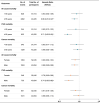Associations of timing of physical activity with all-cause and cause-specific mortality in a prospective cohort study
- PMID: 36805455
- PMCID: PMC9938683
- DOI: 10.1038/s41467-023-36546-5
Associations of timing of physical activity with all-cause and cause-specific mortality in a prospective cohort study
Abstract
There is a growing interest in the role of timing of daily behaviors in improving health. However, little is known about the optimal timing of physical activity to maximize health benefits. We perform a cohort study of 92,139 UK Biobank participants with valid accelerometer data and all-cause and cause-specific mortality outcomes, comprising over 7 years of median follow-up (638,825 person-years). Moderate-to-vigorous intensity physical activity (MVPA) at any time of day is associated with lower risks for all-cause, cardiovascular disease, and cancer mortality. In addition, compared with morning group (>50% of daily MVPA during 05:00-11:00), midday-afternoon (11:00-17:00) and mixed MVPA timing groups, but not evening group (17:00-24:00), have lower risks of all-cause and cardiovascular disease mortality. These protective associations are more pronounced among the elderly, males, less physically active participants, or those with preexisting cardiovascular diseases. Here, we show that MVPA timing may have the potential to improve public health.
© 2023. The Author(s).
Conflict of interest statement
The authors declare no competing interests.
Figures


References
Publication types
MeSH terms
LinkOut - more resources
Full Text Sources

